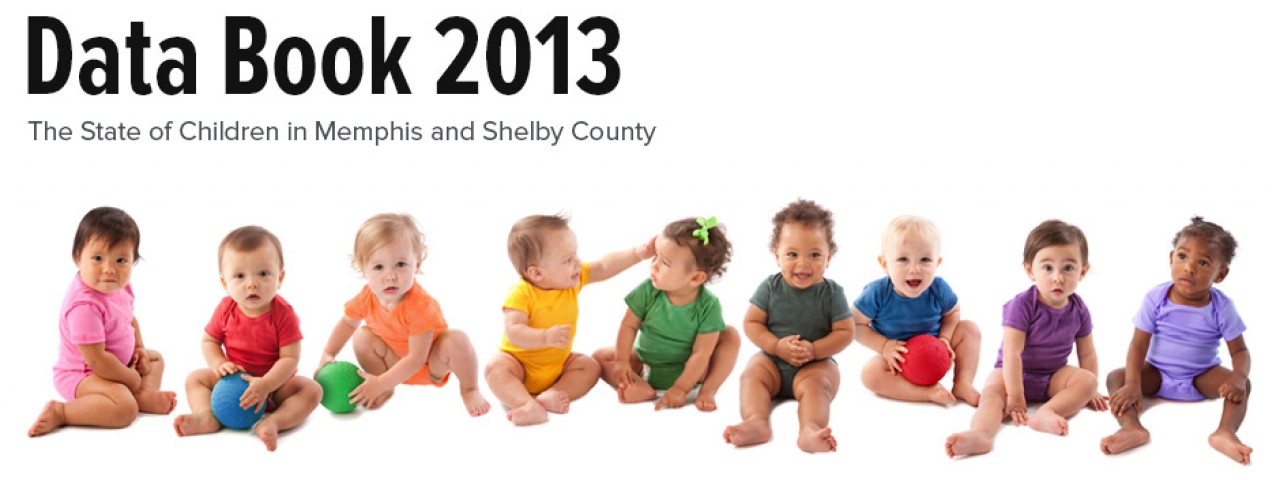Family & Home
A positive home environment is the foundation for healthy brain development.
Children’s surroundings have a huge impact on their well-being. A healthy, safe home is essential for a child to grow, learn and explore. A problematic home environment, by contrast, can have detrimental effects on a child’s intellectual, social and emotional development. Research has shown that a negative home environment during the early years of life can lead to impaired development, including
- poor language skills
- behavioral problems
- deficits in school readiness1-3
A child’s early home environment has also been linked to longer-term outcomes, including
- high school graduation
- teen parenthood
- adult employment and earnings4–6
Brain imaging studies suggest that growing up in a disadvantaged or stressful environment can cause the brain to develop differently. Studies of young children have identified distinct patterns of brain activity associated with family income and other socio-economic factors that relate to social and emotional development, cognitive ability, and learning and memory.7–9
Family poverty puts children at a disadvantage.
Each year, around 14,000 babies are born in Shelby County and more than half are born into families with incomes below the poverty line. Poverty can have a profound effect on a child’s development and later life outcomes.
Low-income children have fewer enriching experiences and learning resources than higher-income children. While parents with stable and sufficient incomes are able to provide their children with plenty of books, enriching activities and high-quality childcare, low-income parents find it more difficult to provide their children with experiences that support optimal brain development.10
But lack of money is only part of the story. The stress that often accompanies economic hardship means that low-income parents often have fewer social and emotional resources as well. For instance, poor and low-income mothers are more likely to be affected by stress, anxiety and depression, which can undermine positive parenting.11,12 Young children in low-income families typically hear fewer spoken words than their middle-income peers, and they also hear a higher proportion of negative statements.13
FIGURE 1 shows the poverty status of families with children living in Shelby County. Poverty is not evenly distributed across Shelby County: 32 percent of Memphis families with children are below the poverty line, compared to only 7 percent of suburban Shelby County families with children.
FIGURE 1: Percent & Number of Families With Children by Poverty Status, Memphis & Suburban Shelby County, 2011
FIGURE 1 shows that families with children in Memphis are more likely to live in poverty than suburban Shelby County families with children.
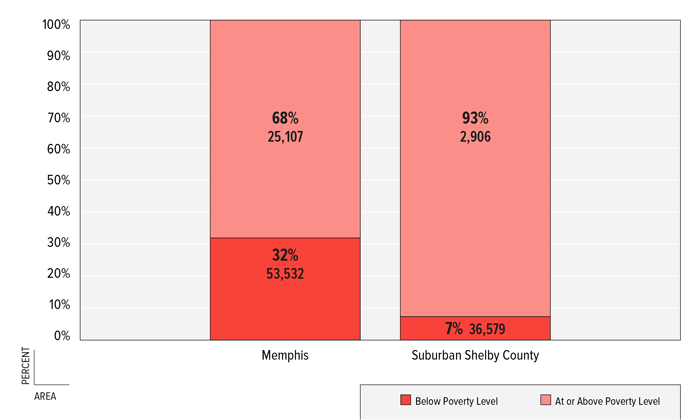
Source: US Census Bureau, American Community Survey, 2007–2011, B17010
Better-educated parents tend to create more positive home environments.
Parents’ educational attainment has an important influence on the environments they create for their children, and it is a predictor of cognitive and behavioral outcomes.14
Studies have linked higher levels of maternal education with
- more parental warmth and responsiveness14
- more learning materials in the home15
- increased school readiness15
- improved educational and employment outcomes throughout life16
Education influences parenting knowledge and beliefs, which, in turn, affect parenting practices and the quality of home environments.15,17
FiGurE 2 shows educational attainment for Shelby County families. 16 percent of Memphis families are headed by an adult with less than a high school education, compared to 5 percent of suburban Shelby County families. 24 percent of Memphis families are headed by an adult with a Bachelor’s degree or higher, compared to 46 percent of suburban Shelby County families.
FIGURE 2: Percent & Number of Families by Educational Attainment of Householder, Memphis & Suburban Shelby County, 2011
FIGURE 2 shows that Memphis families are more likely than suburban Shelby County families to be headed by an adult with less than a high school education.
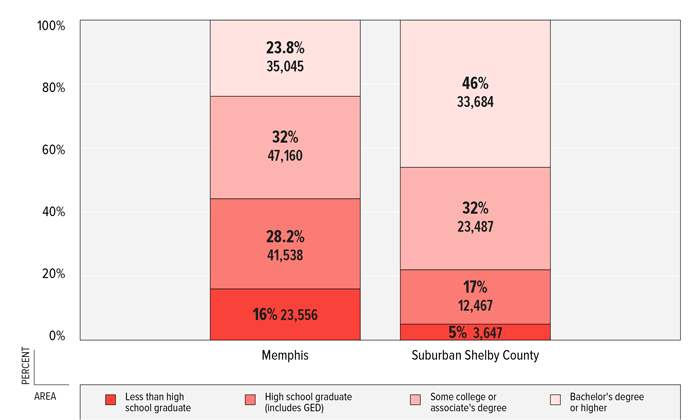
Source: US Census Bureau, American Community Survey, 2007–2011, B17018
Maternal depression is a threat to early childhood development.
Maternal postpartum depression is the most common medical complication of childbearing. While most women experience some symptoms of depression in the first week or two after giving birth, 10 to 15 percent of new mothers develop major depression—often lasting 6 months or longer.18–20
Common symptoms of postnatal depression include sleep disturbances, feelings of guilt and loss of interest in daily activities. Together, these symptoms often make it impossible for new mothers to provide positive experiences that encourage healthy brain development. This can lead to negative behavioral outcomes, including withdrawal, passivity and problems with self-regulation.21,22
Early exposure to disengaged or unresponsive parenting is also predictive of poorer academic outcomes later in childhood. A longitudinal study showed lower IQ scores, more attention problems, and more learning difficulties in children whose mothers suffered from depression at three months postpartum.23
The Conditions Affecting Neurocognitive Development and Learning in Early Childhood (CANDLE) is an ongoing study of approximately 1,500 Shelby County women and their young children. Mothers enroll in their second trimester and participate until their child is three years old.
Mothers in the CANDLE study complete a brief assessment to screen for possible depression at 4 weeks after birth and again at 12 months. While not an actual diagnosis, an “At Risk” score indicates that a mother is likely to be suffering from post-partum depression and that further assessment is recommended.
FIGURE 3 indicates that at four weeks postpartum, more than 11 percent of mothers scored “At Risk.” At 12 months postpartum, almost 10 percent scored “At Risk.”
FIGURE 3: Percent of CANDLE Mothers “At Risk” for Depression, Shelby County, 2012
Figure 3 indicates that around 10 percent of mothers in the CANDLE study were at risk for maternal depression.
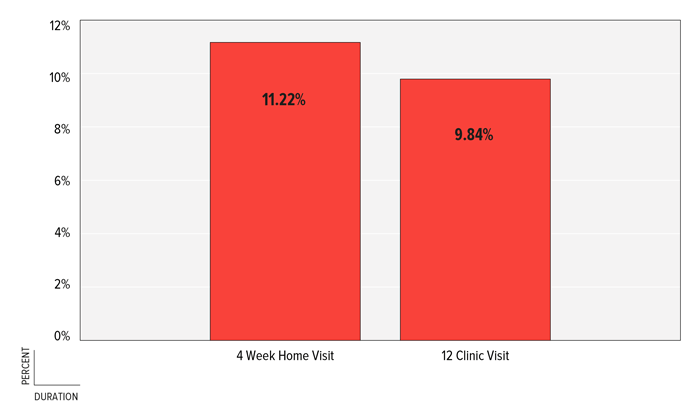
Source: Tylavsky, F., Atkins, J. K., Atkins, R., Bush, A., et al. (2013). Conditions Affecting Nuerocognitive Development and Learning in Early Childhood. Unpublished
FIGURE 4: Percent & Number of Families by Tenure, Memphis & Suburban Shelby County, 2011
As shown in FIGURE 4, Memphis has a lower proportion of home-owning families than suburban Shelby County.
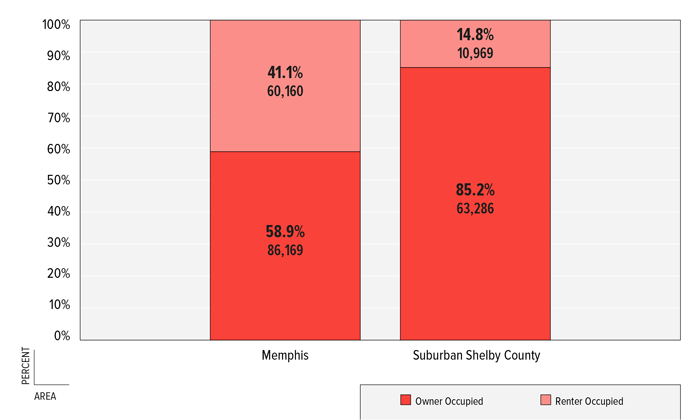
Source: US Census Bureau, American Community Survey, 2007–2011, B11012
Home ownership affects child and adolescent outcomes.
Home ownership is beneficial to families and to the communities in which they live. Recent studies show that it is also specifically associated with child well-being. There is a growing literature that suggests family home ownership improves early cognitive and behavioral development.
For example, a recent study shows that living in a home-owning family is associated with higher educational attainment at age 7.17 Others show that the benefits of homeownership continue into adolescence and young adulthood. Children who grow up in owner-occupied homes are less likely to drop out of high school and less likely to become a teen parent.5,6
FIGURE 4 shows the distribution of home ownership among Shelby County families. 59 percent of Memphis families own their homes, compared to 85 percent of suburban Shelby County families.
Crowded living conditions can interfere with healthy development.
Overcrowding is a risk factor in children’s development. Crowding tends to reduce the quality of the caregiving environment, and it can affect children even during infancy.24
Residential density (number of people per room) has been linked with cognitive and behavioral outcomes as well as physical health.25
Crowding is also associated with parenting behaviors, even after accounting for income and education. In families living in crowded conditions, parents tend to be less sensitive, less verbally responsive, and more punitive.26
Overcrowding is defined as more than one person per room.27 According to data from the U.S. Census Bureau, crowding does not appear to be widespread in Shelby County.
Still, there are significant differences in risk based on family characteristics:
- Black families are three times more likely than white families to live in crowded conditions (3.7 percent vs. 1.2 percent).
- Almost 15 percent of Hispanic families live in overcrowded conditions.
FIGURE 5 shows that only 1.2 percent of white homes are overcrowded, compared to 3.7 percent of black homes and 14.5 percent of Hispanic homes.
FIGURE 5: Percent & Number of Households by Overcrowding by Race, Shelby County, 2011
FIGURE 5 shows that only 1.2 percent of white homes are overcrowded, compared to 3.7 percent of black homes and 14.5 percent of Hispanic homes.
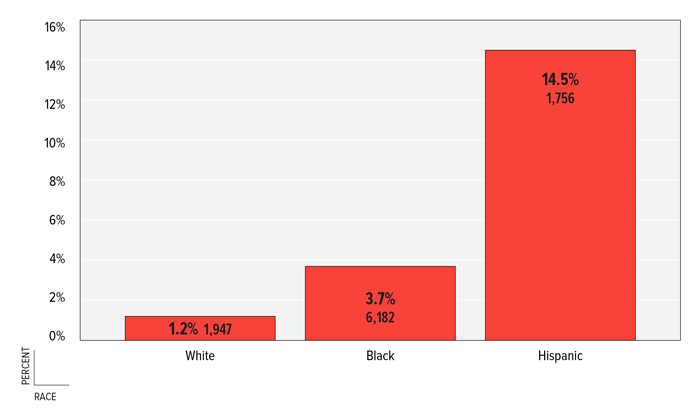
Source: US Census Bureau, American Community Survey, 2007–2011, B25014
Grandparent-headed families may need extra support to ensure positive child outcomes.
Across the U.S. the number of children living with their grandparents has increased significantly in the past several years. This phenomenon is a significant concern because family structure has been shown to have a profound impact on child well-being—most significantly on physical and mental health.28
Grandparent-headed households often emerge due to negative life events. For example, children who receive primary care from their grandparents are more likely to have a teenage parent, a parent with substance abuse issues, an incarcerated parent, or a parent with health problems.29 Because of these risk factors, children from grandparent-headed households are more likely to experience emotional and behavioral difficulties than children living in a traditional home with their biological parents.30
Despite these risks, grandparent-headed families can be a positive alternative to foster care or an unstable parental home. Grandparents have been shown to provide a more caring and stable environment than foster care or other alternatives.31 However, because of the adverse circumstances from which these families often emerge, extra support services can help prepare grandparents for caregiving responsibilities and ensure improved outcomes for their grandchildren.
FIGURE 6 shows the distribution of households with a grandparent responsible for grandchildren under 18 in Memphis and suburban Shelby County. Two percent of suburban Shelby County homes are headed by grandparents, compared to 4.5 percent of Memphis homes.
FIGURE 6: Number & Percent of Households with Grandparent(s) Responsible for Children Under 18 Years, Memphis & Suburban Shelby County, 2011
FIGURE 6 shows that Memphis has a higher proportion of grandparent-headed families than suburban Shelby County.
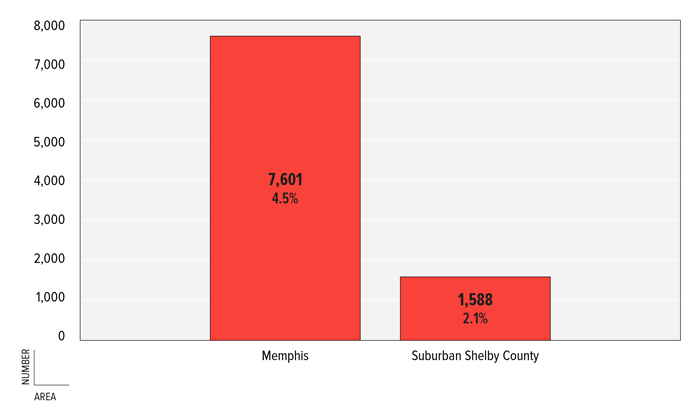
Source: US Census Bureau, American Community Survey, 2007–2011, B10063
FIGURE 7: Percent & Number of Families by Presence of Children by Family Type, Memphis & Suburban Shelby County, 2011
As shown by FIGURE 7, Memphis has a lower percentage of families with married parents compared to suburban Shelby County.
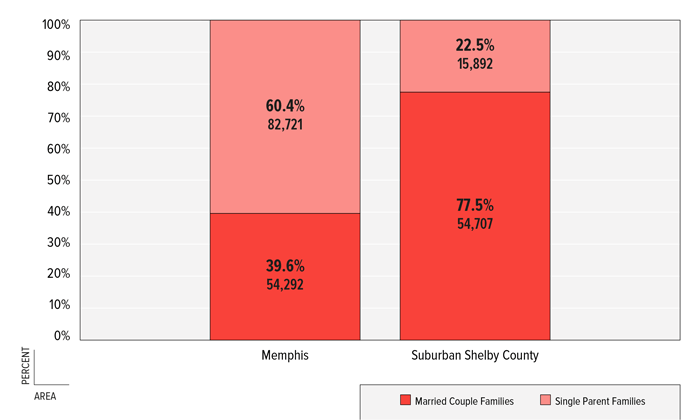
Source: US Census Bureau, American Community Survey, 2007–2011, B09002
Research has linked child well-being to family type.
Research over the past several decades has shown that family structure is a strong predictor of child outcomes. Specifically, growing up with only one parent has been associated with a number of negative outcomes.
Compared to children living with their married parents, children in single-parent families are at a greater risk of
- behavioral issues32
- poor health33
- low self-esteem34
- alcohol and substance abuse35
- risky sexual behavior36
- high school dropout37
An enriching and stimulating home environment fosters healthy growth and brain development by providing a child with love, emotional support, and opportunities for learning and exploration. In families where only one parent is present, there are often fewer economic and emotional resources. Competing demands at work and at home can hinder a parent’s ability to provide an environment conducive to learning and development.38
FIGURE 7 compares family structure in Memphis and suburban Shelby County. In Memphis, married families make up about 40 percent of families with children. In suburban Shelby County, 77.5 percent of families with children have married parents.
- Evans GW, Ricciuti HN, Hope S, et al. The mediating role of maternal responsiveness among 36-month-old children. Environment and Behavior. 2010; 42(1):135–148.
- Trentacosta CJ, et al. The relations among cumulative risk, parenting, and behavior problems during early childhood. Journal of Child Psychology and Psychiatry. 2008; 49:1211–1219.
- Vernon-Feagans L, Garrett-Peters P, Willoughby M, et al. Chaos, poverty, and parenting: Predictors of early language development. Early Childhood Research Quarterly. 2011; 27:339–351.
- Duncan GJ, Ziol-Guest KM, Kalil A. Early childhood poverty and adult attainment, behavior, and health. Child Development. 2010; 81:306–325.
- Green R, White M. Measuring the benefits of homeowning: effects on children. Journal of Urban Economics. 1997; 41:441–461.
- Aaronson, D. A note on the benefits of homeownership. Journal of Urban Economics. 2000; 47:356–369.
- Gianaros PJ. Socioeconomic health disparities: A health neuroscience and lifecourse perspective. Psychological Science Agenda. 2011; 25(1).
- Noble KG, Houston SM, Kan E, et al. Neural correlates of socioeconomic status in the developing human brain. Developmental Science. 2012; 15(4):516–527.
- Hanson JL, Chandra A, Wolfe BL, et al. Association between income and the hippocampus. PLoS ONE. 2011; 6(5):e18712.
- Lugo-Gil J, Tamis-LeMonda C. Family resources and parenting quality: links to children’s cognitive development across the first 3 years. Child Development. 2008; 79:1065–1085.
- Linver M, Brooks-Gunn J, Kohen D. Family processes as pathways from income to young children’s development. Developmental Psychology. 2002; 38:719–734.
- Yeung WJ, Linver MR, Brooks- Gunn J. How money matters for young children’s development: Parental Investment and Family Processes. Child Development. 2002; 73(6):1861–1879.
- Hart B, Risley TR. Meaningful differences in the everyday experience of young American children. Baltimore, MD: Paul H. Brookes Publishing; 1995.
- Davis-Kean PE, et al. The influence of parent education and family income on child achievement: The indirect role of parental expectations and the home environment. Journal of Family Psychology. 2005; 19:294–304.
- Magnuson KA, Sexton HR, Davis-Kean PE, et al. Increases in maternal education and young children’s language skills. Merrill-Palmer Quarterly. 2009; 55 (3):319–350.
- Dubow EF, Boxer P, Huesmann LR. Long-term effects of parents’ education on children’s educational and occupational success. Merrill-Palmer Quarterly. 2009; 55(3):224–249.
- Jones E, Gutman L, Platt L. Family Stressors and Children’s Outcomes. Childhood Wellbeing Research Centre. London: Dept. of Education. 2013.
- Field T, Hernandez-Reif M, Diego M. Intrusive and withdrawn depressed mothers and their infants. Developmental Review. 2006; 26:15–30.
- Parsons CE, Young KS, Murray L, et al. The functional neuroanatomy of the evolving parent–infant relationship. Progress in Neurobiology. 2010; 91:220–241.
- Sit DK, Wisner KL. The identification of postpartum depression. Clinical Obstetrics and Gynecology. 2009; 52(3):456–468.
- Cohn J, Tronick E. Specificity of infants’ response to mothers’ affective behavior. Journal of the American Academy of Child and Adolescent Psychiatry. 1998; 28:242–248.
- Canadian Paediatric Society. Maternal depression and child development. Paediatrics & Child Health. 2004; 9(8):575–583.
- Hay DF, et al. Intellectual problems shown by 11-year-old children whose mothers had postnatal depression. Journal of Child Psychology and Psychiatry. 2001; 42:871–879.
- Lanza ST et al. Modeling multiple risks during infancy to predict quality of the caregiving environment: contributions of a person-centered approach. Infant Behavior & Development. 2011; 34:390–406.
- Leventhal T, Newman S. Housing and child development. Children and Youth Service Review. 2010; 32 (9):1165–1174.
- Kopko K. The effects of the physical environment on children’s development. Cornell University Department of Human Development. 2007. Available at: http://www.human.cornell.edu/che/HD/Outreach_extension/upload/Physical-Environment-Evans.pdf.
- Blake KS, et al. Measuring overcrowding in housing. Washington, DC: Department of Housing and Urban Development, Office of Policy Development and Research. 2007. Available at: http://www.huduser.org/portal/publications/ahsrep/measuring_overcrowding.html.
- Murphey D, et al. Children Living with Grandparents: State-Level Data from the American Community Survey. Child Trends Research Brief: Washington, DC. 2012.
- Pinson-Milburn NM, et al. Grandparents raising grandchildren. Journal of Counseling and Development. 1996; 74:548–554.
- Dubowitz H, et al. Children in kinship care: how do they fare? Children and Youth Services Review. 1994; 16:85–106.
- Hayslip B, Kaminski PL. Grandparents raising their grandchildren: A review of the literature and suggestions for practice. The Gerontologist. 2005; 45:262–269.
- Dornbusch SM, et al. Single parents, extended households, and the control of adolescents. Child Development. 1985; 45:326–341.
- Dawson D. Family Structure and Children’s Health: United States, 1988. Data from the National Health Survey No 178. Washington, DC: Centers for Disease Control, National Center for Health Statistics, US Department of Health and Human Services. 1991.
- Parish TS. Ratings of self and parents by youth: Are they affected by family status, gender, and birth order? Adolescence. 1991; 26:105–112.
- Covey LS, Tam D. Depressive mood, the single- parent home, and adolescent cigarette smoking. American Journal of Public Health. 1990; 80:1330–1333.
- Thornton A, Camburn D. The influence of the family on premarital sexual attitudes and behavior. Demography. 1987; 24:323–340.
- Astone NM, McLanahan S. Family structure, parental practices, and high school completion. American Sociological Review. 1991; 6:309–320.
- Carlson MJ, Corcoran ME. Family structure and children’s behavioral and cognitive outcomes. Journal of Marriage and Family. 2001; 63(3):779–792.
